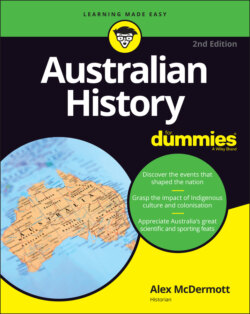Читать книгу Australian History For Dummies - Alex McDermott - Страница 106
GETTING THROUGH THE BLUE MOUNTAINS BLUES
ОглавлениеFor the first 25 years of white settlement, the Blue Mountains were a big problem. They formed a ring around the NSW settlements at Sydney, Parramatta and on the Hawkesbury River. If a way wasn’t found through the mountains, the colony would never reach its full potential.
The Blue Mountains weren’t like the regular ‘ordinary’ mountains the European settlers were used to. In order to cross European mountains, you found the valleys that went between the peaks and followed them. But this wouldn’t work with the Blue Mountains because their geological formation had been completely different. Rather than being peaks of land that had been thrust up by subterranean forces, the Blue Mountains formed part of a range that had originally been a plateau. Formed from sandstone rock, countless aeons had worn down most of the plateau, forming gorges and gaps between other parts that had retained their height. This meant that if you followed the valleys you wouldn’t go between the peaks, but would just find yourself running into walls and dead ends.
Between 1793 and 1804, numerous attempts were made to cross the Blue Mountains, with no success. The attempt in 1804 was made by George Cayley, a young protégé of Sir Joseph Banks (refer to Chapter 3 for more on this rich botanist who had fingers in just about every Australian pie). Cayley reported back to the governor at the time, Governor King, that it was useless to try to cross such a ‘confused and barren assemblage of mountains’.
King agreed with Cayley. Moreover, he was worried about the rumours that kept inspiring convicts to run away: The distant view of the purple-blue mountains (which, of course, is how they got their name) was so inviting that convicts kept running away, believing that on the other side was a land where everything was perfectly lovely. King said this was stupid, and forbade people to try any further mountain crossings. And there, for the next ten years or so, is where the matter rested.
However, in 1813, Governor Macquarie, who liked the idea of pushing the settlement outward, hopefully discovering more fertile land and finding new outlets for the increasing population, encouraged a new attempt. Gregory Blaxland, a gentleman settler, William Wentworth, native-born youth, and Lieutenant Lawson set off from near Penrith. They tried a different strategy to the other explorers — rather than follow the valleys and try to hoist themselves over the ridges, they climbed up onto a ridge and kept following it. This way they got past and through the mountains, and happily reported on the fertile land on the other side.
The group hadn’t actually managed to get all the way through the bigger Great Dividing Range — that happened a year later with surveyor G W Evans — but they penetrated far enough to show how it could be done, and got a fair share of public acclaim for doing it. Finally, the colony could begin to properly expand into the Australian continent.
